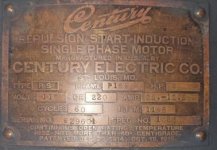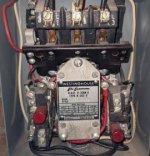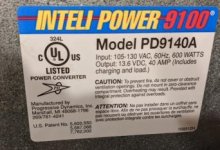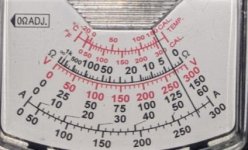Hi,
I'm a trustee for a small church with an early 1900's 2HP Century Repulsion start induction single phase motor driving a blower for our organ.
It's controlled by circa 1956 Westinghouse life-linestarter class 11-200 3 phase Type N (wired as 2-phase 3-wire circuit)
The linestarter is fed through a double-pole fusebox with (2) Type T 15 amp slow-blow fuses
In the past two weeks we've encountered a problem with the motor. After about an hour of operation, the linestarter trips.
We sent the motor to a local motor/pump repair company
They:
Despite this, the motor controller still trips.
I've found a note on the controller that claims in 2012, startup current was about 45 amps and run current was 10.0 amps and 10.5 amps (L1 & L2)
This week (after repair) I measured the current using two different meters and found startup current to be 45/43 amps (L1 vs L2) and run current is 14.7 and 14.2 amps. (there is a 600 watt DC transformer on L1, accounting for the addl 0.5 amps)
The clamp meter I used claims an accuracy of 2% + 6D (I'm not sure what 6D means)
I have no idea how accurate the the notes from 2012 are.
Between L1 and L2 its 241 volts (motor not running)
The motor nameplate indicates it will use 12.5 amps at 220 volts
I ran the motor for 1.5 hours w/o tripping by leaving the cover off the linestarter box.
I used an IR camera to measure the temperature change of various parts of the motor.
The top of the motor housing increased from 70F to 120F (a 27C change)
The stator increased from 70F to 150F (a 44C change)
The motor nameplate says a 40C rise is allowed. Would this be the temperature change of the frame, or of the stator?
I spoke with the organ repair company and they explained how the blower and airbox work. Essentially the blower is always pushing against the spring pressure of the air chest. The only way to increase the load on the motor would be to restrict the air intake. However the air intake is not restricted.
The linestarter is currently using size BE14 heaters, theoretically a 125% overload protection range of 11.9 to 12.8 amps
Can anyone answer these questions?
1. What else should we check to track down why the current load has increased in the past 9 years?
2. Since the protection range of the heaters is 11.9 to 12.8, does this mean they are slightly adjustable? If yes, how would I adjust them?
3. Would it be acceptable to go to the next larger heater, BF16 12.9 to 13.8 amps?
Thanks for any suggestions you may have.
Here's a video of startup and shutdown https://youtu.be/HBPSiir-a-8




I'm a trustee for a small church with an early 1900's 2HP Century Repulsion start induction single phase motor driving a blower for our organ.
It's controlled by circa 1956 Westinghouse life-linestarter class 11-200 3 phase Type N (wired as 2-phase 3-wire circuit)
The linestarter is fed through a double-pole fusebox with (2) Type T 15 amp slow-blow fuses
In the past two weeks we've encountered a problem with the motor. After about an hour of operation, the linestarter trips.
We sent the motor to a local motor/pump repair company
They:
- cleaned armature & grooves where brushes run
- adjusted brushes
- tested all coils for opens/shorts to ground, shorts to other coils
- checked bearings
- replaced oil in bearings
Despite this, the motor controller still trips.
I've found a note on the controller that claims in 2012, startup current was about 45 amps and run current was 10.0 amps and 10.5 amps (L1 & L2)
This week (after repair) I measured the current using two different meters and found startup current to be 45/43 amps (L1 vs L2) and run current is 14.7 and 14.2 amps. (there is a 600 watt DC transformer on L1, accounting for the addl 0.5 amps)
The clamp meter I used claims an accuracy of 2% + 6D (I'm not sure what 6D means)
I have no idea how accurate the the notes from 2012 are.
Between L1 and L2 its 241 volts (motor not running)
The motor nameplate indicates it will use 12.5 amps at 220 volts
I ran the motor for 1.5 hours w/o tripping by leaving the cover off the linestarter box.
I used an IR camera to measure the temperature change of various parts of the motor.
The top of the motor housing increased from 70F to 120F (a 27C change)
The stator increased from 70F to 150F (a 44C change)
The motor nameplate says a 40C rise is allowed. Would this be the temperature change of the frame, or of the stator?
I spoke with the organ repair company and they explained how the blower and airbox work. Essentially the blower is always pushing against the spring pressure of the air chest. The only way to increase the load on the motor would be to restrict the air intake. However the air intake is not restricted.
The linestarter is currently using size BE14 heaters, theoretically a 125% overload protection range of 11.9 to 12.8 amps
Can anyone answer these questions?
1. What else should we check to track down why the current load has increased in the past 9 years?
2. Since the protection range of the heaters is 11.9 to 12.8, does this mean they are slightly adjustable? If yes, how would I adjust them?
3. Would it be acceptable to go to the next larger heater, BF16 12.9 to 13.8 amps?
Thanks for any suggestions you may have.
Here's a video of startup and shutdown https://youtu.be/HBPSiir-a-8










